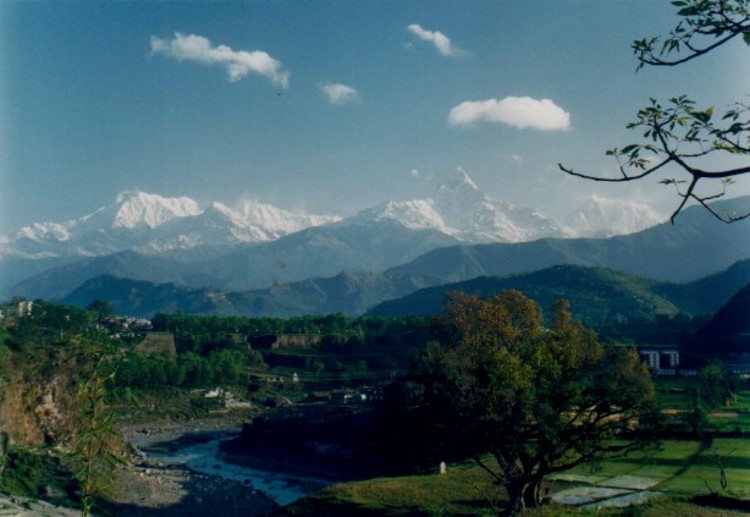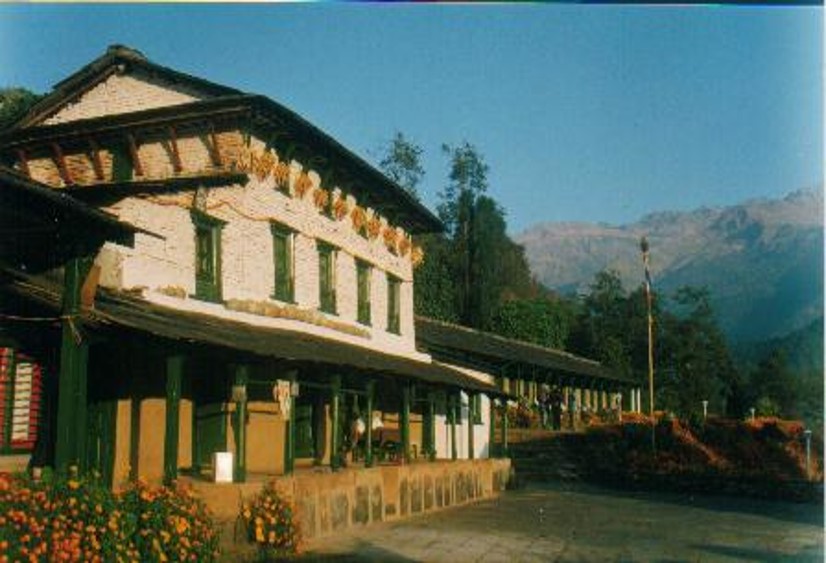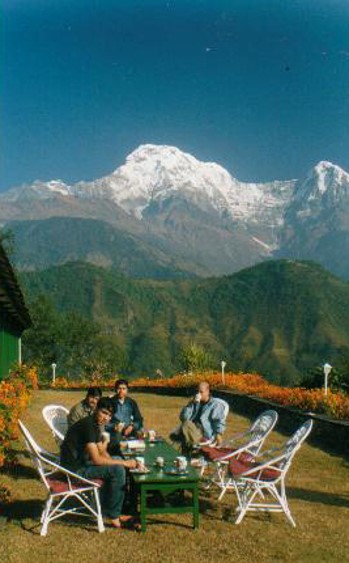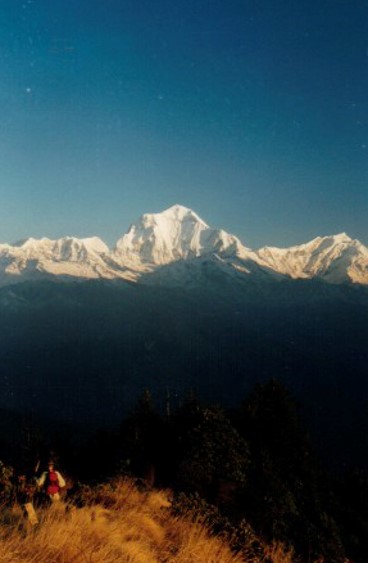Narrative and photography by P Ravi Shankar

Pokhara, Nepal is one of the few places in the world where towering snow-clad mountains are easily seen from a subtropical setting. The town is at a height of around 900 meters and within a span of around 40 kilometres, the land rises to the summit of Annapurna at over 8000 meters. The view of colourful poinsettias and bougainvillea against the blue sky and the white peaks creates a picture postcard setting. The soft limestone rocks are easily eroded by powerful glacial-fed rivers creating deep gorges. The hills surrounding Pokhara have many charming villages and one can also follow the river valleys to the Annapurna Sanctuary (a pasture situated between the Annapurna peaks) and to the land of Mustang.


I was at Kalopani in Mustang. The morning was bright and sunny, but the air was still chilly. The dining room was heated, and many tourists were having their breakfast before continuing their treks. The Nilgiri Himals (snow-covered mountains in Nepali) were clear in the bright morning sunshine. We were waiting for our pooris to arrive.
My friend and I were hiking up toward the Thakali (the major ethnic group in this area) settlements of Tukuche and Marpha. The dining room was big, and the glass windows had spectacular views of the pine forests. We were at the Pine Forest Lodge in the twin settlements of Lete and Kalopani. The settlement continues for over thirty minutes on both sides of the trail. The lodge is big by trekking lodge standards and has sixteen rooms. Run by the Dhawlagiri Technical school, this facility is often used to train tourism students. The manager informed us that the number of tourists they can accept every day is limited due to an agreement with similar businesses in the area. Now, it also offers free wi-fi services. When we visited in the early 2000s, cellular and internet services were still in the future.
Our pooris finally arrived. They were fluffy and brownish red. A potato and peas gravy accompanied the pooris. The dish was thick and spicy. The small hill potatoes were tasty.
The lodge constructed of stone can be cold during the nights, but comforters are provided to guests. I always had pleasant stays at this lodge. I never had the opportunity to meet trainee students as usually they started their sessions only after nine in the morning. By that hour, we were already out on the trail.


The Red House Lodge in Kagbeni is a bewildering warren of rooms and passages. Kagbeni is on the way to the holy shrine of Muktinath and hikers without the expensive permit to Upper Mustang can watch the trail meandering through the Kali Gandaki River and the barren brown hills. The Red House Lodge is an iconic establishment and several stories and blogs have been written about it. The lodge is a traditional, red-coloured Tibetan house and was started by Pema Doma in 1997 when the region was opened to tourists. She developed a beautiful friendship with an Australian lady, Sydney Schuler. The small house that served as the lodge did not have a name and she then decided to install a signboard inscribed with ‘Red House Lodge’. There are Tibetan religious texts and a Tibetan shrine with a five feet statue of the Buddha at the centre. Firewood and provisions dry in the harsh sun on the flat roof and there is a large pole with prayer flags flapping in the wind.
From the roof, you can gaze at the dreamy landscapes of upper Mustang and watch the constantly changing play of light on the barren hills. By mid-morning strong winds roar from the Tibetan plateau. Tibetans use both the wind and water to carry their prayers far and wide. The lodge was used to store rations by the Khampa resistance fighters, who struggled against cultural hegemony in the mid-twentieth century. Kham in eastern Tibet was one of the three traditional provinces and the Khampas (the inhabitants) have a reputation as tough fighters. They eventually migrated to Nepal along with other refugees and waged armed resistance to free Tibet till they were eventually disarmed by the Nepalese army in the 1970s. Kesang in the Mustang region was one of the main centres of the Khampa resistance. The food at the lodge in Kesang is excellent and it is a good place to rest either on your way up to or down from Muktinath. The sense of history is strong in this lodge as a comfortable familiarity with the past blends into the present.
Ghandruk is a large Gurung village near Pokhara and the headquarters of the Annapurna Conservation Area Project (ACAP). Gurungs are an ethnic group dominant in the hills around Pokhara. Along with other ethnicities they constitute the famous Gurkhas known for their courage and valour. Gurungs are believed to have originated in Tibet and practice a mixture of animistic, Hindu, and Buddhist religious practices. They live on the southern slopes of the Himalayas in central Nepal and call themselves Tamu. Many serve in the Nepalese, Indian, British and other armies and police forces and have seen action in several conflicts.
Due to the civil war, many Gurungs migrated from their villages to settle in Pokhara. Ghandruk (also called Ghandrung) is the second largest Gurung village in Nepal after Siklis. The village sprawls over a hillside with terraced fields. From the road head at Nayapul (new bridge), Ghandruk is a four-to-five-hour trek initially along the riverbank and then through well-maintained stone staircases. The Himalaya Lodge (a Kerr and Downey resort) is located right at the top of the village. This lodge lets out rooms to independent trekkers if not occupied by those who have reserved their rooms through Kerr and Downey.


The lodge has spectacular views of the Annapurna Himals. The dining room is decorated in the Gurung style. The food at the lodge served in traditional copper utensils is excellent. The freshly plucked green leafy vegetables and the radish pickle are tasty. The rooms are well-appointed with attached bathrooms. You sleep between freshly laundered white sheets. The lodge provides guests with slippers and down jackets for their use during their stay. There are tables and comfortable chairs placed in the stone-paved courtyard for al fresco dining and you can watch the clouds gather and eventually cloak the Himals. Butterflies and birds flit among the flowers. The lodge also has different handicrafts for sale. I was first introduced to the singing bowl or the Himalayan bowl here. The traditional bowls were originally made of a variety of metals including mercury, lead, silver, iron, gold, and copper. I found it fascinating that by moving a wooden stick around the bowl a rich harmonious note could be produced.
Ghorepani at around 2800 m is famous for the views of the Annapurna and Dhaulagiri Himals. The viewing of sunrise at Poon Hill is a highlight of the trek. I usually stay at the Snow View lodge located close to Poon Hill. The lodge is made of wood and has an excellent solar hot shower. They have a single room with a window providing excellent views. The cast-iron stove in the dining room is warm and the food is excellent. Ghorepani is a long day’s climb on steep stone staircases from Nayapul and Birethanti. Climbing to Poon hill from the lodges using flashlights in the predawn darkness is a unique experience. Ghorepani was a watering hole for horses till it was discovered by tourists. The settlement has several lodges both down in the main village and higher up at Deurali (the pass). The rhododendrons during spring bloom in various shades of red and pink. The cornbread baked at Snow View lodge is excellent and is my breakfast of choice.


The last few years have been hard on the trekking lodges. First, there was the devastating earthquake of 2015 which damaged the infrastructure, and then the global shutdown due to the coronavirus pandemic. The lodge owners are resilient and resourceful. The lodges offer comfortable alternatives to staying in cold tents and also contribute to the local economy. Now, as the world is beginning to open its doors again to tourism and travel, I look forward to returning to the magic of the Himalayas and revisiting these wonderful lodges.

Dr. P Ravi Shankar is a faculty member at the IMU Centre for Education (ICE), International Medical University, Kuala Lumpur, Malaysia. He enjoys traveling and is a creative writer and photographer.
.
PLEASE NOTE: ARTICLES CAN ONLY BE REPRODUCED IN OTHER SITES WITH DUE ACKNOWLEDGEMENT TO BORDERLESS JOURNAL